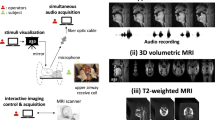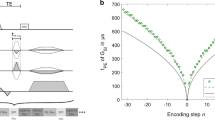Abstract
Objective
Speech production MRI benefits from lower magnetic fields due to reduced off-resonance effects at air-tissue interfaces and from the use of dedicated receiver coils due to higher SNR and parallel imaging capability. Here we present a custom designed upper airway coil for 1H imaging at 0.55 Tesla and evaluate its performance in comparison with a vendor-provided prototype 16-channel head/neck coil.
Materials and methods
Four adult volunteers were scanned with both custom speech and prototype head–neck coils. We evaluated SNR gains of each of the coils over eleven upper airway volumes-of-interest measured relative to the integrated body coil. We evaluated parallel imaging performance of both coils by computing g-factors for SENSE reconstruction of uniform and variable density Cartesian sampling schemes with R = 2, 3, and 4.
Results
The dedicated coil shows approximately 3.5-fold SNR efficiency compared to the head–neck coil. For R = 2 and 3, both uniform and variable density samplings have g-factor values below 1.1 in the upper airway region. For R = 4, g-factor values are higher for both trajectories.
Discussion
The dedicated coil configuration allows for a significant SNR gain over the head–neck coil in the articulators. This, along with favorable g values, makes the coil useful in speech production MRI.







Similar content being viewed by others
Data availability statement
Data and code from this work are available at: Code: github.com/usc-mrel/speech_coil_eval, Data: zenodo.org/record/5898595.
References
Bresch E, Yoon-Chul K, Nayak K et al (2008) Seeing speech: capturing vocal tract shaping using real-time magnetic resonance imaging [Exploratory DSP]. IEEE Signal Process Magn 25:123–132. https://doi.org/10.1109/MSP.2008.918034
Scott AD, Wylezinska M, Birch MJ, Miquel ME (2014) Speech MRI: Morphology and function. Physica Med 30:604–618. https://doi.org/10.1016/j.ejmp.2014.05.001
Pauloski BR, Logemann JA, Rademaker AW et al (1993) Speech and swallowing function after anterior tongue and floor of mouth resection with distal flap reconstruction. J Speech Lang Hear Res 36:267–276. https://doi.org/10.1044/jshr.3602.267
Wyatt R, Sell D, Russell J et al (1996) Cleft palate speech dissected: a review of current knowledge and analysis. Br J Plast Surg 49:143–149. https://doi.org/10.1016/S0007-1226(96)90216-7
Cao B, Sebkhi N, Mau T et al (2019) Permanent Magnetic Articulograph (PMA) vs Electromagnetic Articulograph (EMA) in Articulation-to-Speech Synthesis for Silent Speech Interface. In: Proceedings of the eighth workshop on speech and language processing for assistive technologies. Association for computational linguistics, Minneapolis, Minnesota, pp 17–23
Rebernik T, Jacobi J, Jonkers R et al (2021) A review of data collection practices using electromagnetic articulography. Lab Phonol: J Assoc Lab Phonol 12:6. https://doi.org/10.5334/labphon.237
Preston JL, Leece MC, Maas E (2016) Intensive treatment with ultrasound visual feedback for speech sound errors in childhood Apraxia. Front Hum Neurosci. https://doi.org/10.3389/fnhum.2016.00440
Veis S, Logemann JA, Colangelo L (2000) Effects of three techniques on maximum posterior movement of the tongue base. Dysphagia 15:142–145. https://doi.org/10.1007/s004550010016
Hayes A, Alspaugh JM, Bartelt D et al (2009) Radiation safety for the speech-language pathologist. Dysphagia 24:274–279. https://doi.org/10.1007/s00455-008-9201-0
Schenck JF (1996) The role of magnetic susceptibility in magnetic resonance imaging: MRI magnetic compatibility of the first and second kinds. Med Phys 23:815–850. https://doi.org/10.1118/1.597854
Lim Y, Lingala SG, Narayanan SS, Nayak KS (2019) Dynamic off-resonance correction for spiral real-time MRI of speech. Magn Reson Med 81:234–246. https://doi.org/10.1002/mrm.27373
Lim Y, Bliesener Y, Narayanan S, Nayak KS (2020) Deblurring for spiral real-time MRI using convolutional neural networks. Magn Reson Med 84:3438–3452. https://doi.org/10.1002/mrm.28393
Lim Y, Nayak KS (2022) Real-time MRI of speech production at 0.55 Tesla. In: ISMRM 31st Scientific Session. London, England, United Kingdom
Bhattacharya I, Ramasawmy R, Restivo MC, Campbell-Washburn AE (2019) Dynamic speech imaging at 0.55T using single shot spirals for 11ms temporal resolution. In: ISMRM 27th Scientific Session. Montreal QC, Canada
Symms M (2004) A review of structural magnetic resonance neuroimaging. J Neurol Neurosurg Psychiatry 75:1235–1244. https://doi.org/10.1136/jnnp.2003.032714
Plantinga BR, Temel Y, Roebroeck A et al (2014) Ultra-high field magnetic resonance imaging of the basal ganglia and related structures. Front Hum Neurosci 8
Nayak KS, Lim Y, Campbell-Washburn AE, Steeden J (2022) Real-time magnetic resonance imaging. J Magn Reson Imaging 55:81–99. https://doi.org/10.1002/jmri.27411
Kim Y-C, Hayes CE, Narayanan SS, Nayak KS (2011) Novel 16-channel receive coil array for accelerated upper airway MRI at 3 Tesla. Magn Reson Med. https://doi.org/10.1002/mrm.22742
Lingala SG, Zhu Y, Kim Y et al (2017) A fast and flexible MRI system for the study of dynamic vocal tract shaping. Magn Reson Med. https://doi.org/10.1002/mrm.26090
Hon Tat Hui (2008) Decoupling methods for the mutual coupling effect in antenna arrays: a review. Recent Patents Eng 1:187–193. https://doi.org/10.2174/187221207780832200
Campbell-Washburn AE, Ramasawmy R, Restivo MC et al (2019) Opportunities in interventional and diagnostic imaging by using high-performance low-field-strength MRI. Radiology 293:384–393. https://doi.org/10.1148/radiol.2019190452
Yushkevich PA, Piven J, Hazlett HC et al (2006) User-guided 3D active contour segmentation of anatomical structures: significantly improved efficiency and reliability. Neuroimage 31:1116–1128. https://doi.org/10.1016/j.neuroimage.2006.01.015
Roemer PB, Edelstein WA, Hayes CE et al (1990) The NMR phased array. Magn Reson Med 16:192–225. https://doi.org/10.1002/mrm.1910160203
Kellman P, McVeigh ER (2005) Image reconstruction in SNR units: a general method for SNR measurement. Magn Reson Med 54:1439–1447. https://doi.org/10.1002/mrm.20713
Pruessmann KP, Weiger M, Bö P, Boesiger P (2001) Advances in Sensitivity Encoding With Arbitrary k-Space Trajectories
Akcakaya M, Basha TA, Manning WJ, Nezafat R (2014) Efficient calculation of g-factors for CG-SENSE in high dimensions: noise amplification in random undersampling. J Cardiovasc Magn Reson 16:W28. https://doi.org/10.1186/1532-429x-16-s1-w28
De Zwart JA, Ledden PJ, Van Gelderen P et al (2004) Signal-to-noise ratio and parallel imaging performance of a 16-channel receive-only brain coil array at 3.0 tesla. Magn Reson Med 51:22–26. https://doi.org/10.1002/mrm.10678
Fujita H, Zheng T, Yang X et al (2013) RF surface receive array coils: the art of an LC circuit: RF surface receive array coils. J Magn Reson Imaging 38:12–25. https://doi.org/10.1002/jmri.24159
Corea JR, Lechene PB, Lustig M, Arias AC (2017) Materials and methods for higher performance screen-printed flexible MRI receive coils: high-performance screen-printed flexible MRI receive coils. Magn Reson Med 78:775–783. https://doi.org/10.1002/mrm.26399
Hoult DI (1969) Lauterbur PC (1979) The sensitivity of the zeugmatographic experiment involving human samples. J Magn Reson 34:425–433. https://doi.org/10.1016/0022-2364(79)90019-2
Giovannetti G, Hartwig V, Landini L, Santarelli MF (2012) Classical and lateral skin effect contributions estimation in strip MR coils. Concepts Magn Reson 41B:57–61. https://doi.org/10.1002/cmr.b.21210
Acknowledgements
We acknowledge grant support from the National Science Foundation (#1828736) and research support from Siemens Healthineers.
Author information
Authors and Affiliations
Corresponding author
Ethics declarations
Conflict of interest
Dr. Sophia Cui is an employee of Siemens Healthcare.
Ethical standards
All procedures involving human subjects were in accordance with the local ethics board.
Informed consent
Written informed consent was obtained in all cases.
Additional information
Publisher's Note
Springer Nature remains neutral with regard to jurisdictional claims in published maps and institutional affiliations.
Supplementary Information
Below is the link to the electronic supplementary material.
An example of real-time speech production imaging with the custom upper airway coil. The data were acquired while the subject was counting from 1 to 5 at normal and then speeded rates. Imaging was performed with a spiral-based balanced steady-state free precession pulse sequence with parameters: TR: 5.3 ms, flip angle: 35˚, FOV: 28cm2, slice thickness: 6 mm, in-plane spatial resolution: 2.3x2.3 mm2, and temporal resolution: 10.6 ms/frame. The image series was reconstructed using a sparse SENSE reconstruction with a temporal finite difference constraint (acceleration factor = 6.5) Supplementary file1 (MP4 8551 kb)
Rights and permissions
Springer Nature or its licensor holds exclusive rights to this article under a publishing agreement with the author(s) or other rightsholder(s); author self-archiving of the accepted manuscript version of this article is solely governed by the terms of such publishing agreement and applicable law.
About this article
Cite this article
Muñoz, F., Lim, Y., Cui, S.X. et al. Evaluation of a novel 8-channel RX coil for speech production MRI at 0.55 T. Magn Reson Mater Phy 36, 419–426 (2023). https://doi.org/10.1007/s10334-022-01036-0
Received:
Revised:
Accepted:
Published:
Issue Date:
DOI: https://doi.org/10.1007/s10334-022-01036-0




